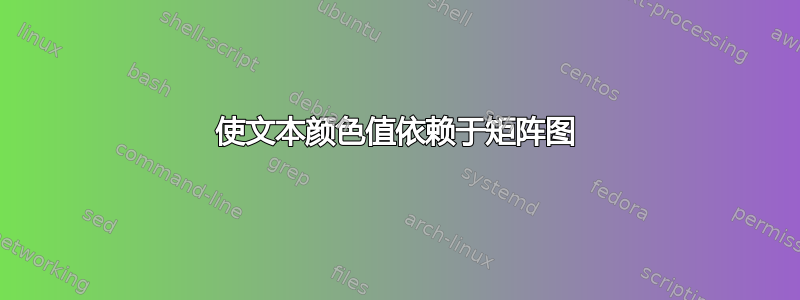
我正在尝试调整这个情节:
... 让注释根据值改变颜色。 50% 以上应为白色,50% 以下应为黑色。
我隐约觉得这可能很简单,但我不知道该怎么做,也找不到例子告诉我怎么做。任何帮助我都非常感谢。
答案1
这可以通过修改来实现这个答案。
有关其工作原理的详细信息,请查看代码中的注释。
% used PGFPlots v.1.14
\documentclass[border=5pt]{standalone}
\usepackage{pgfplots}
\pgfplotsset{
width=5cm,
height=18cm,
compat=1.3,
colormap={blackwhite}{gray(0cm)=(1); gray(1cm)=(0.5)},
xticklabels={LPIBG, ALL, HPIBG},
xtick={0,...,2},
ytick=\empty,
}
\begin{document}
\begin{tikzpicture}
\begin{axis}[
enlargelimits=false,
xlabel style={font=\footnotesize},
ylabel style={font=\footnotesize},
legend style={font=\footnotesize},
xticklabel style={font=\footnotesize},
yticklabel style={font=\footnotesize},
colorbar,
colorbar style={
ytick={0,20,40,60,80,100},
yticklabels={0,20,40,60,80,100},
yticklabel={\pgfmathprintnumber\tick\,\%},
yticklabel style={font=\footnotesize}
},
point meta min=0,
point meta max=100,
nodes near coords={\pgfmathprintnumber\pgfplotspointmeta\,\%},
% ---------------------------------------------------------------------
% show `nodes near coords' but adapt the style so that values
% above a threshold get another style
% (adapted from <http://tex.stackexchange.com/a/141006/95441>)
% #1: the THRESHOLD after which we switch to a special display.
nodes near coords black white/.style={
% define the style of the nodes with "small" values
small value/.style={
font=\footnotesize,
yshift=-7pt,
text=black,
},
% define the style of the nodes with "large" values
large value/.style={
font=\footnotesize,
yshift=-7pt,
text=white,
},
every node near coord/.style={
check for zero/.code={
\pgfmathfloatifflags{\pgfplotspointmeta}{0}{
% If meta=0, make the node a coordinate
% (which doesn't have text)
\pgfkeys{/tikz/coordinate}
}{
\begingroup
% this group is merely to switch to FPU locally.
% Might be unnecessary, but who knows.
\pgfkeys{/pgf/fpu}
\pgfmathparse{\pgfplotspointmeta<#1}
\global\let\result=\pgfmathresult
\endgroup
%
% simplifies debugging:
%\show\result
%
\pgfmathfloatcreate{1}{1.0}{0}
\let\ONE=\pgfmathresult
\ifx\result\ONE
% AH: our condition 'y < #1' is met.
\pgfkeysalso{/pgfplots/small value}
\else
% ok, proceed as usual.
\pgfkeysalso{/pgfplots/large value}
\fi
}
},
check for zero,
},
},
% asign a value to the new style thich is the threshold at which
% the two style `small value' or `large value' are used
nodes near coords black white=50,
% -----------------------------------------------------------------
]
\addplot[
matrix plot,
mesh/cols=3,
point meta=explicit,
] table [meta=C] {
x y C
0 0 80
1 0 36
2 0 40
0 1 64
1 1 80
2 1 60
0 2 52
1 2 84
2 2 72
0 3 72
1 3 28
2 3 32
0 4 56
1 4 84
2 4 80
0 5 72
1 5 52
2 5 44
0 6 4
1 6 84
2 6 41
0 7 37
1 7 69
2 7 84
0 8 63
1 8 53
2 8 82
0 9 78
1 9 74
2 9 39
0 10 39
1 10 63
2 10 88
0 11 76
1 11 74
2 11 49
0 12 39
1 12 6
2 12 88
0 13 46
1 13 33
2 13 75
0 14 88
1 14 67
2 14 54
0 15 79
1 15 83
2 15 75
0 16 50
1 16 46
2 16 71
0 17 92
1 17 71
2 17 75
0 18 46
1 18 33
2 18 8
};
\end{axis}
\end{tikzpicture}
\end{document}



